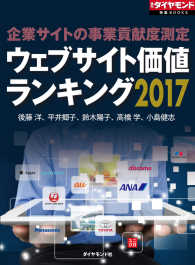- ホーム
- > 洋書
- > 英文書
- > Science / Mathematics
Full Description
Communications technologies increasingly pervade our everyday lives, yet the underlying principles are a mystery to most. Even among engineers and technicians, understanding of this complex subject remains limited. However, there is undeniably a growing need for all technology disciplines to gain intimate awareness of how their fields are affected by a more densely networked world. The computer science field in particular is profoundly affected by the growing dominance of communications, and computer scientists must increasingly engage with electrical engineering concepts. Yet communications technology is often perceived as a challenging subject with a steep learning curve.
To address this need, the authors have transformed classroom-tested materials into this accessible textbook to give readers an intimate understanding of fundamental communications concepts. Readers are introduced to the key essentials, and each selected topic is discussed in detail to promote mastery. Engineers and computer scientists will gain an understanding of concepts that can be readily applied to their respective fields, as well as provide the foundation for more advanced study of communications.
Provides a thorough grounding in the basics by focusing on select key concepts
Clarifies comprehension of the subject via detailed explanation and illustration
Helps develop an intuitive sense of both digital and analog principles
Introduces key broadcasting, wireless and wired systems
Helps bridge the knowledge gap between software and electrical engineering
Requires only basic calculus and trigonometry skills
Classroom tested in undergraduate CS and EE programs
Communications Engineering by Lee, Chiu, and Lin will give advanced undergraduates in computer science and beginning students of electrical engineering a rounded understanding of communications technologies. The book also serves as a key introduction to specialists in industry, or anyone who desires a working understanding of communications technologies.
Contents
Preface vii
1 An Overview of Computer Communications 1
Further Reading 3
2 Signal Space Representation 5
2.1 The Vector Space 6
2.2 The Signal Space 7
2.3 Summary 14
Further Reading 15
Exercises 15
3 Fourier Representations of Signals 17
3.1 The Fourier Series 20
3.2 Cosine-only Expansion of Fourier Series 33
3.3 Fourier Series in Complex Exponentials 37
3.4 The Fourier Transform 48
3.5 Physical Meaning of Fourier Transform 54
3.6 Properties of the Fourier Transform 56
3.7 Fourier Transform Representations for Periodic Signals 64
3.8 The Discrete Fourier Transform 68
3.9 The Inverse Discrete Fourier Transform 77
3.10 Physical Meaning of the Discrete Fourier Transform 78
Further Reading 92
Exercises 92
4 Analog Modulation Techniques 97
4.1 Amplitude Modulation 98
4.2 Double-sideband Suppressed Carrier (DSB-SC) 107
4.3 Single-sideband (SSB) Modulation 111
4.4 Frequency Modulation (FM) 119
4.5 Superheterodyne AM and FM Receivers 127
4.6 Analog Modulation with Frequency Division Multiplexing 131
4.7 Concluding Remarks 132
Further Reading 133
Exercises 133
5 Digital Modulation Techniques 135
5.1 Baseband Pulse Transmission 136
5.2 Amplitude-shift Keying (ASK) 141
5.3 Binary Phase-shift Keying (BPSK) 146
5.4 Binary Frequency-shift Keying (FSK) 151
5.5 Quadriphase-shift Keying (QPSK) 157
5.6 Quadrature Amplitude Modulation 165
5.7 Orthogonal Frequency Division Multiplexing (OFDM) 169
5.8 OFDM in Wireless Local Area Networks 181
5.9 Digital Audio Broadcast Using OFDM and TDMA 183
5.10 The Role of Inner Product in Digital Modulation 185
5.11 Review of Digital Modulation Techniques 186
Further Reading 187
Exercises 187
6 Multiple-access Communications 189
6.1 Frequency-division Multiple Access (FDMA) 190
6.2 Time-division Multiple Access (TDMA) 192
6.3 Code-division Multiple Access (CDMA) 196
6.4 Carrier-sense Multiple Access (CSMA) 204
6.5 The Multiplexing Transmission Problem 205
Further Reading 206
Exercises 206
7 Spread-spectrum Communications 209
7.1 The Basic Concept of Spread-spectrum 209
7.2 Baseband Transmission for Direct-sequence Spread-spectrum (DSSS) Communications 212
7.3 BPSK Modulation for DSSS 218
7.4 Pseudo-random Binary Sequence 220
7.5 Frequency-hopping Spread-spectrum 222
7.6 Application of Spread-spectrum Techniques to Multiple-access Systems 224
Further Reading 230
Exercises 230
8 Source Coding and Channel Coding 231
8.1 Average Codeword Length of Source Coding 233
8.2 Prefix Codes 234
8.3 Huffman Coding 235
8.4 Channel Coding 237
8.5 Error-correcting Capability and Hamming Distance 237
8.6 Hamming Codes 239
8.7 Convolutional Codes 243
Further Reading 250
Exercises 250
Appendix 253
Bibliography 255
Index 257
-

- 電子書籍
- 煌宮~偽りの煌妃、後宮に入っても大人し…
-

- 電子書籍
- 大人の問題【分冊】 7巻 ハーレクイン…
-

- DVD
- 淫花(復刻スペシャルプライス版)
-

- 電子書籍
- ウェブサイト価値ランキング2017 週…
-

- 電子書籍
- フィギュアスケートLife Vol.4…



